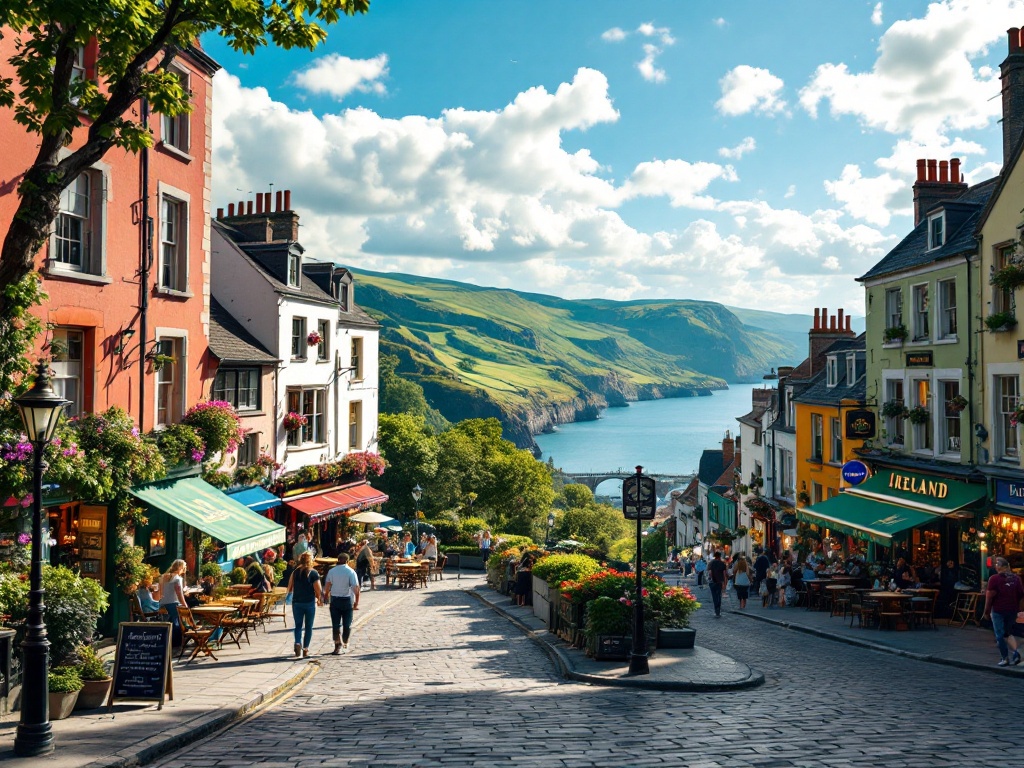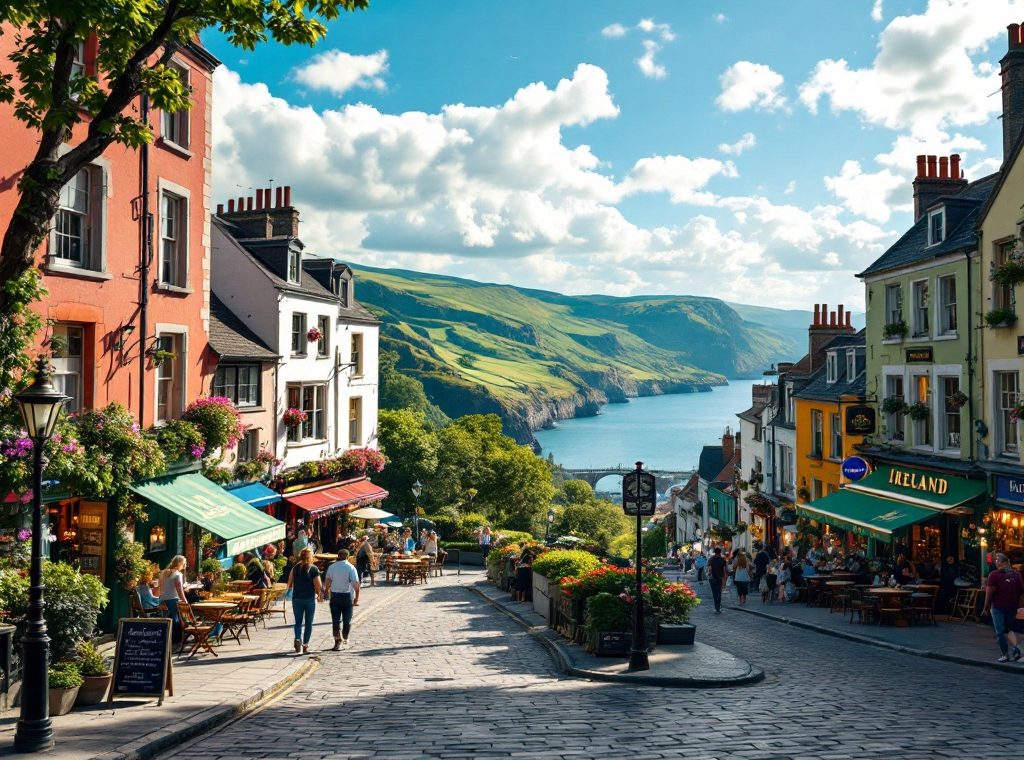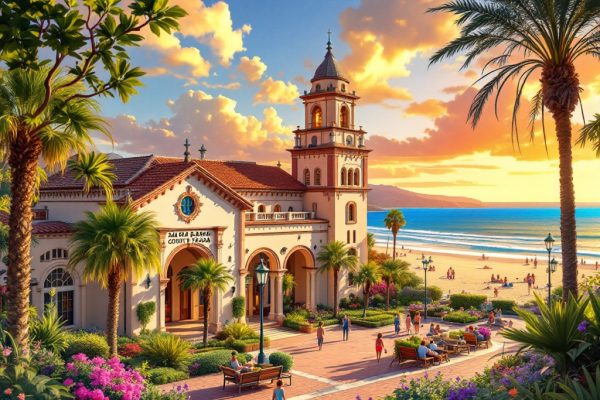Planning a Trip to Ireland: Instructions for Firts-Time Travelers
Dreaming of Ireland? From vibrant Dublin to the scenic Ring of Kerry, this comprehensive guide helps you plan your perfect Irish getaway. Discover must-see attractions, transportation tips, and insider advice on everything from visa requirements to cultural etiquette. Uncover hidden gems, savor traditional cuisine, and explore breathtaking landscapes with our suggested itineraries. Start planning your unforgettable Irish adventure today!
Important information

- Book flights and accommodation early, especially during peak season.
- Pack for all types of weather; conditions can change rapidly. Bring a waterproof jacket.
- The Republic of Ireland uses the euro (€), and Northern Ireland uses the British pound (£). Credit cards are widely accepted.
- Driving is on the left. If renting a car, an International Driving Permit might be required.
- Consider travel insurance for emergencies and check visa requirements (if applicable) before traveling.
Introduction to Planning a Trip to Ireland
Planning your trip to Ireland? Here’s how to get started:
Determine your travel dates and desired length of stay. Consider your interests: vibrant cities like Dublin and Galway, or the scenic Ring of Kerry.
Sketch a preliminary itinerary. List must-see attractions, accommodations, and transportation plans.
Check travel restrictions, visa requirements, and typical weather for your travel dates. Checking currency exchange rates can also save you money.
Book flights and accommodations early. Travel insurance is a wise investment.
Strive for a balanced itinerary. Combine urban exploration with rural adventures for a richer Irish experience.
Enjoy your trip!
Why Visit Ireland?
Ireland offers breathtaking landscapes, from dramatic cliffs to lush green valleys. Rich in history, the country’s ancient castles and lively cities whisper stories of bygone eras. Known for their friendly hospitality, the Irish welcome visitors to a safe and enjoyable travel experience. Here, you can savor traditional music, explore fascinating historical sites, and immerse yourself in the captivating blend of Ireland’s vibrant culture—a fusion of ancient heritage and modern life.
Essential Travel Tips for First-Time Visitors
Planning a trip to Ireland? Be prepared for unpredictable weather by packing a variety of clothing options. Essential items for your trip include travel insurance and your passport. A flexible itinerary is also key, allowing you to adapt to Ireland’s ever-changing climate.
Must-See Destinations
- Cliffs of Moher: Experience the breathtaking beauty of these iconic cliffs.
- Giant’s Causeway: Marvel at this geological wonder.
- Dublin: Explore the vibrant capital city.
- Galway: Discover the charm of this lively city on the west coast.
Getting Around
Consider renting a car, but remember that driving is on the left side of the road in Ireland. Alternatively, take advantage of Ireland’s excellent public transportation options, including buses and trains, or book domestic flights for longer distances.
It is highly recommended to book accommodations in advance, especially during peak season.
Entry Requirements and Visa Information
Irish entry requirements depend on your nationality. EU, EEA, and Swiss citizens can enter visa-free. Many other nationalities, including those from the United States, Canada, Australia, and New Zealand, can also enter without a visa, usually for up to 90 days. However, always check the latest visa requirements for your country on the Irish Naturalisation and Immigration Service (INIS) website before you travel.
Republic of Ireland
- Dublin Airport (DUB),
- Cork Airport (ORK),
- Shannon Airport (SNN).
Northern Ireland
- Belfast International Airport (BFS),
- George Best Belfast City Airport (BHD).
Ferry routes connect Ireland with the UK and mainland Europe, with various ports of entry. Entry rules may differ between the Republic of Ireland and Northern Ireland. Consult the respective government websites for up-to-date entry procedures and travel restrictions.
Visa Requirements for Ireland
Your nationality determines whether you need a visa to visit Ireland. EU, EEA, and Swiss citizens can enter visa-free. Many other nationalities can also travel to Ireland without a visa for up to 90 days. However, some nationalities must obtain a visa before traveling. For accurate information and to ensure a smooth trip, consult the Irish Naturalisation and Immigration Service (INIS) website before you travel.
Entry Points to the Republic of Ireland and Northern Ireland
Traveling to Ireland offers a variety of convenient options. Fly into Dublin Airport (DUB), the main international hub, or choose from other airports such as Cork (ORK), Shannon (SNN), and Knock (NOC) for access to the Republic of Ireland. Belfast International (BFS) and George Best Belfast City Airport (BHD) serve Northern Ireland. Ferries are another popular choice, with routes to Dublin, Rosslare, and Belfast.
Booking Flights and Time Savers
Find affordable flights to Ireland by traveling during the off-season. Being flexible with your travel dates is key to securing the best deals. Compare fares to several airports for the cheapest options:
- Dublin (DUB),
- Shannon (SNN),
- Cork (ORK),
- Knock (NOC).
Ground transportation is readily available at each airport, with options including taxis, buses, and rental cars. A little planning before your trip will ensure a seamless airport transfer and help you organize your onward journey effectively.
Flight Booking Tips
Find the best flight deals using comparison websites like Skyscanner and Google Flights. Booking in advance, especially during popular travel times, often guarantees lower fares. Consider flying into smaller, less busy airports to save money. For example, instead of Dublin (DUB), explore options like Shannon (SNN) or Knock (NOC). You might be surprised by the savings.
Airport Transit and Local Transportation
Reaching Dublin (DUB), Shannon (SNI), and Cork (ORK) airports is easy. Several ground transportation options are available, including:
- buses,
- taxis, and
- rental cars.
Budget travelers may prefer public transport, while those prioritizing convenience can pre-book airport transfers.
Transportation Options in Ireland
Travel around Ireland with ease by renting a car, ideal for picturesque routes such as the Ring of Kerry and the Wild Atlantic Way. Remember that driving is on the left side of the road. While automatic transmissions are available, they usually come at a higher cost. Depending on your country of origin, an International Driving Permit may be required, so it’s recommended to verify the specific requirements.Alternatively, Ireland offers a comprehensive public transport system. Buses and trains connect major cities and towns, often providing real-time information and online booking. For cost savings, consider a Leap Card, which offers discounts in certain areas.For quick long-distance travel, domestic flights are a practical choice. If you prefer a more personal experience, biking or walking lets you enjoy the local scenery at your own speed.
Road Trip
- Breathtaking views.
- Schedule flexibility.
- Explore at your own pace.
Public Transport
- Relaxed experience.
- No parking hassles.
- Reduced driving stress.
When choosing between a road trip and public transport, consider your available time, budget, and desired level of independence to select the best travel option for your Irish adventure.
Car Rental and Left-Side Driving
Renting a car is the perfect way to explore Ireland’s stunning scenery, especially iconic routes like the Wild Atlantic Way. Remember that driving is on the left side of the road in Ireland, so it’s recommended to practice beforehand if you’re not used to it. If you find shifting gears with your left hand difficult, consider choosing an automatic transmission.
Public Transport Options
Traveling throughout Ireland? Public transport offers a practical and affordable way to experience the Emerald Isle. Buses and trains connect major cities and towns, simplifying travel between destinations. For exploring Dublin, the Leap Visitor Card provides cost-effective travel within the city.
Traveling Between Cities
Irish Rail efficiently links major hubs like Dublin, Cork, and Galway, offering a comfortable journey.
Reaching Remote Areas
To reach more remote destinations, consider Bus Éireann’s extensive network, which even services the smallest villages.
Planning your routes and schedules in advance will optimize your travel time.
Road Trip vs. Public Transit: Choosing the Best Option
Public Transport
Public transport offers a cost-effective way to navigate cities and towns.
Rental Car
A rental car provides unparalleled freedom, especially for venturing into remote regions like the Wild Atlantic Way, with its breathtaking coastal drives. Plus, you’re in charge of your own schedule.
Itinerary Planning and Top Destinations
Experience Ireland in one week! Explore Dublin, Galway, and the majestic Cliffs of Moher. In Dublin, discover the historical treasures of Trinity College and Dublin Castle. Galway offers a vibrant arts scene and stunning coastal views. The Cliffs of Moher will take your breath away with their dramatic cliffs and vast ocean vistas.
Suggested Itinerary
Dublin: Explore Trinity College and Dublin Castle.
Galway: Immerse yourself in the vibrant arts scene and enjoy the coastal views.
Cliffs of Moher: Witness the dramatic cliffs and vast ocean vistas.
Off-the-Beaten-Path Adventures
Aran Islands: Discover unique island life.
Connemara: Explore the rugged beauty of the region.
Local Interactions: Talk to locals, uncover hidden gems, and create unforgettable memories.
1 Week Trip Itinerary
Day 1: Dublin – History and Heritage
Begin your Irish adventure in Dublin. Explore the historic Trinity College and the magnificent Dublin Castle.
Day 2: Dublin – Guinness and Irish History
Immerse yourself in the world of Guinness at the Guinness Storehouse. Learn all about this famous stout. Afterwards, visit Kilmainham Gaol for a moving glimpse into Ireland’s past. Conclude your day with a traditional Irish dinner.
Day 3: Galway – Medieval Charm
Journey to Galway and wander its charming medieval streets. Soak in the vibrant atmosphere and enjoy live music.
Day 4: Cliffs of Moher and The Burren
Experience the breathtaking Cliffs of Moher and the unique landscape of The Burren. This will be an unforgettable experience.
Day 5: Cork and Blarney Castle
Travel to Cork and visit the legendary Blarney Castle. Kiss the Blarney Stone for good luck.
Day 6: Cork City Exploration
Discover Cork city. Visit St. Fin Barre’s Cathedral and delve into the city’s rich culture.
Day 7: Departure
Depart from either Cork or Dublin, marking the end of your Irish journey.
Must-See Attractions: Dublin, Cork, Galway
Dublin
Explore Dublin’s iconic landmarks:
- Trinity College, home to the Book of Kells.
- The historic Dublin Castle.
- The Guinness Storehouse for a pint of the black stuff.
- Kilmainham Gaol, a sobering reminder of Irish history.
Cork
Cork offers a different kind of Irish experience:
- Kiss the Blarney Stone at Blarney Castle.
- Marvel at St. Fin Barre’s Cathedral’s architecture.
- Explore the Cork City Gaol.
- Sample local delicacies at the vibrant English Market.
Galway
Experience Galway’s unique atmosphere and charm:
- Visit Galway Cathedral.
- Walk beneath the Spanish Arch.
- Discover the legend of the Claddagh Ring.
- Enjoy stunning views from Salthill Promenade.
Off the Beaten Path: Hidden Gems and Cultural Landscapes
Discover Ireland’s hidden gems. Explore the Aran Islands off the Galway coast, with their striking landscapes, ancient forts like Dún Aonghasa, and vibrant traditional music. Embark on the Copper Coast Scenic Drive in County Waterford, revealing breathtaking coastal vistas and charming seaside towns. Journey into Ireland’s monastic past at the well-preserved ruins of Clonmacnoise in County Offaly or the Rock of Cashel in County Tipperary, a captivating blend of history with its cathedral, chapel, and round tower. Each destination offers a unique glimpse into Ireland’s rich traditions and local culture.
Aran Islands
Explore ancient forts such as Dún Aonghasa and enjoy traditional Irish music.
Copper Coast Scenic Drive
Discover breathtaking coastal vistas and charming seaside towns.
Clonmacnoise
Delve into Ireland’s monastic past at the well-preserved ruins.
Rock of Cashel
Explore a captivating blend of history with its cathedral, chapel, and round tower.
Exploring Ireland’s Natural Beauty
Connemara National Park in County Galway offers a diverse landscape of mountains, bogs, and grasslands. Further south in County Clare, the Burren National Park presents a unique karst landscape worth exploring. County Kerry’s Killarney National Park features the stunning Lakes of Killarney and the historic Muckross House and Gardens. For scenic hikes and diverse wildlife, visit Wicklow Mountains National Park.
Spanning 2,500 km along Ireland’s western edge, the Wild Atlantic Way offers a breathtaking coastal drive from Donegal to Cork. A shorter, yet equally captivating option is the 179 km Ring of Kerry, circling the Iveragh Peninsula with its mountains, coastline, and lakes.
- Explore the Irish landscape with a guided hike through the Wicklow Mountains or the Dingle Peninsula.
- Alternatively, day tours provide convenient transport and expert commentary for popular destinations like the Cliffs of Moher and the Giant’s Causeway.
National Parks and Nature Sites
Connemara National Park, located in the west of Ireland, offers breathtaking mountains and expansive bogs.
Killarney National Park in County Kerry features spectacular scenery, as well as the historic Killarney House and Gardens.
Explore the unique karst landscape of The Burren in County Clare.
South of Dublin, Wicklow Mountains National Park provides scenic trails for hikers.
Glenveagh National Park in County Donegal combines natural beauty with a castle and gardens.
Scenic Routes: Wild Atlantic Way and Ring of Kerry
Discover Ireland’s captivating west coast with two unforgettable journeys. For an extended exploration, embark on the 2,500 km (1,553 mile) Wild Atlantic Way. This stunning route showcases dramatic coastal scenery. If you prefer a shorter adventure, the 179 km (111 mile) Ring of Kerry loop in County Kerry offers a condensed taste of Ireland’s beauty. Here, dramatic mountains meet shimmering lakes and a rugged coastline, dotted with charming towns. Enjoy outdoor activities like hiking and cycling, or savor unforgettable scenic drives.
Wild Atlantic Way
Explore the breathtaking 2,500 km (1,553 mile) route along Ireland’s west coast. Experience dramatic coastal scenery.
Ring of Kerry
Discover the captivating 179 km (111 mile) loop in County Kerry. See where dramatic mountains, shimmering lakes, and a rugged coastline meet, punctuated by charming towns.
Enjoy activities such as:
- hiking,
- cycling,
- scenic drives.
Guided Hikes and Day Tours
Discover Ireland’s breathtaking scenery through guided hikes and day trips. Explore iconic sites like the Cliffs of Moher, Giant’s Causeway, and Connemara National Park with enriching commentary from local guides. They’ll share fascinating insights into the area’s history, geology, and folklore. Whether you prefer a relaxing walk or a challenging climb, tours cater to all fitness levels. Transportation is generally included, simplifying your travel arrangements. Booking in advance, particularly during peak season, secures your place.
Plan Your Irish Adventure
To find your ideal tour, consider:
- group size,
- tour duration,
- included activities.
Booking Advice
Booking in advance is recommended, especially during peak season, to secure your spot on the tour.
Accommodation Choices
Ireland offers a wide range of accommodation options to suit every budget and travel style. From budget-friendly hostels to luxurious castle hotels, you’re sure to find the perfect place to stay. For those looking to save money, hostels provide basic, often shared rooms and communal spaces. If you’re seeking a unique and unforgettable experience, consider staying in a castle hotel steeped in history and luxury. Guesthouses, B&Bs, and standard hotels are also readily available throughout the country.
Budget-Friendly Options
- Housesitting: Exchange property care for free accommodation.
- Airbnb: Discover a diverse range of apartments, houses, and unique lodgings.
- Camping: Enjoy an economical stay at campsites across Ireland.
Exploring Beyond the Cities
Venture beyond the major cities for a more authentic and often cheaper Irish experience. Smaller towns and rural areas offer stunning landscapes and a slower pace of life, while still providing easy access to major attractions via public transport or car rental.
From Hostels to Castle Hotels
Ireland offers a wide range of accommodations, from budget-friendly hostels to luxurious castle hotels, ensuring there’s something for every traveler. For a unique experience, consider staying in a historic castle. Numerous other options exist across various price points.
Housesitting and Budget Stays
Housesitting offers free accommodation in exchange for pet or home care, making it a great option for budget travelers. Other affordable alternatives include hostels, guesthouses, and budget hotels. Camping is also widely available throughout Ireland.
Staying Outside Big Cities
Escape the urban frenzy and uncover the enchanting secrets of rural Ireland. Experience authentic Irish hospitality in cozy bed and breakfasts, inviting guesthouses, or charming self-catering cottages. Venture beyond the cities to connect with local communities and immerse yourself in traditional Irish culture. Explore breathtaking landscapes, wander along winding hiking trails, and discover ancient historical sites, often enjoying a more tranquil experience away from the city crowds. Discover picturesque coastal towns and villages offering stunning seaside views and invigorating water activities. As an added benefit, rural stays often provide excellent value for your money.
Dining and Irish Cuisine
From hearty stews to fresh seafood, Irish cuisine offers a delightful culinary journey. A bowl of classic Irish stew, brimming with tender lamb or beef, potatoes, and vegetables, is pure comfort food. Pair it with a slice of yeast-free soda bread for a truly authentic experience. For another comforting dish, try colcannon, a flavorful mix of mashed potatoes and cabbage or kale. Along the coast, savor a rich seafood chowder showcasing Ireland’s fresh catches.
Start Your Day the Irish Way
Begin with a “Full Irish” breakfast, a hearty plate of black and white pudding, sausages, bacon, eggs, and tomatoes. Alternatively, a boxty, a traditional potato pancake, might tempt your taste buds.
Sweet Endings
Finish your meal with a sweet treat like a warm apple tart or comforting bread pudding.
Beyond the food, Irish pubs are the heart of Irish social life. Their warm and welcoming atmosphere invites you to relax with a pint of Guinness, Ireland’s iconic stout, or explore the diverse world of Irish whiskeys. Many pubs also feature live traditional music, adding to the lively ambiance.
Traveling on a budget? Local cafes offer affordable coffee, pastries, sandwiches, and light meals. Stock up on fresh produce at local markets, and keep an eye out for early bird specials and lunchtime deals at restaurants for cost-effective dining options.
Traditional Dishes and Irish Food
Irish cuisine offers a delightful array of hearty and flavorful dishes. A classic example is Irish stew, a comforting combination of tender lamb or beef with potatoes and vegetables. For a satisfying bite, try boxty, a type of potato pancake. Another staple is soda bread, a quick bread made without yeast. Colcannon offers a tasty twist on mashed potatoes by incorporating cabbage or kale. Coastal areas boast delicious seafood chowder. A traditional Irish breakfast might include black and white pudding, though be warned, the flavors are distinctive. Finish your meal with a sweet treat like apple tart or bread pudding. And don’t forget to pair your culinary experience with a Guinness, Irish whiskey, or a local craft beer.
Visiting an Irish Pub
Experience the unique atmosphere of an Irish pub. Enjoy local craft beers and live traditional music. The warm and friendly ambiance offers a chance to connect with locals and experience authentic Irish culture.
Budget-Friendly Dining: Coffee and More
Ireland is a great place for budget-conscious food lovers. Cafes offer quick and easy meals, from coffee and pastries to light lunches. For those on the go, numerous takeaway spots provide even faster options. Alternatively, create a memorable experience with a scenic picnic. Stock up on provisions at a local supermarket and savor your meal amidst Ireland’s stunning parks. It’s an affordable way to enjoy delicious food and breathtaking views.
Travel Etiquette and Cultural Insights
Irish, or Gaeilge, is the official first language of Ireland, although English is widely spoken. You’ll mostly hear Irish in the Gaeltacht regions. Common greetings include “Dia dhuit” (Hello) and “Go raibh maith agat” (Thank you), offering a taste of local culture. Irish slang like “craic” (fun and entertainment) provides further insight into Irish social life.
Respectful Interactions
Respectful interactions are essential in Ireland. Avoid loud conversations and respect personal space. When engaging in conversations, steer clear of sensitive topics like politics and religion.
Tipping Etiquette
Tipping is customary in Ireland. In restaurants, 10-15% is standard. For taxis, rounding up the fare is generally acceptable. Offering a drink to the bartender is a thoughtful gesture in pubs, but not required.
Language and Communication: English and Irish Words
While English is widely spoken in Ireland, familiarizing yourself with some Irish phrases can greatly enhance your travel experience. Using greetings such as “Dia dhuit” (hello) and “Slán” (goodbye) shows cultural respect and can lead to more authentic interactions with locals.
Understanding Irish Slang and Cultural Missteps
Interested in Irish slang? “Craic” means fun, and “grand” means okay.
Irish culture values both politeness and hospitality, so engage in conversations, but initially avoid sensitive topics like politics and religion.
Avoid the cliché “top of the morning to ya,” though—it’s rarely used in Ireland.
Respecting personal space is also important, and a simple “thank you” or “cheers” is always appreciated.
Tipping and Social Norms
Tipping in Ireland is customary for a variety of services. In restaurants, a standard tip of 10-15% is expected for good service, showing appreciation for the staff. Taxi drivers also appreciate tips, often by rounding up the fare. A small gratuity is welcomed by hotel staff for services such as luggage assistance. While less common in pubs, tips are suitable for table service.
Safety and Practical Considerations
Given Ireland’s unpredictable weather, packing versatile, layered clothing is essential. A waterproof, windproof jacket is a must-have to protect you from the elements. This ensures you’re prepared for any weather conditions.
Travel insurance is recommended to cover unforeseen circumstances like medical emergencies or trip cancellations. Consulting your doctor about necessary vaccinations is also advised.
The Republic of Ireland uses the euro (€), and credit and debit cards are widely accepted. However, carrying some cash for smaller purchases is always a good idea.
While Northern Ireland uses the British pound (£), euros are often accepted. This offers flexibility in currency usage across the island.
Weather Considerations and Packing Tips
Packing for a trip to Ireland requires a strategic approach due to the changeable weather. Layering is key, so pack versatile clothing items that can be easily adjusted to fluctuating temperatures. Essential items include a waterproof jacket, comfortable walking shoes, and a travel umbrella. While summers are typically mild, winters can be cold and wet, so pack accordingly. Sunscreen and sunglasses are recommended throughout the year. Don’t forget a power adapter for your electronics, your camera to capture the breathtaking scenery, and any necessary medications. A small daypack is useful for carrying essentials like snacks and water during day trips.
Travel Insurance and Health Precautions
Planning a trip to Ireland? Travel insurance is a must-have. It protects you from unexpected costs like medical emergencies, trip cancellations, and lost baggage. Before you go, check local health advisories for recommended vaccinations and precautions. Ireland offers both public and private healthcare. If you have a European Health Insurance Card (EHIC), you can use public healthcare services.
Currency and Payment Methods in Ireland
In the Republic of Ireland, the official currency is the euro (€). Major credit and debit cards are widely accepted. ATMs are readily available throughout the country for cash withdrawals.
It is advisable to notify your bank of your travel plans to avoid any potential issues with your cards. Currency exchange services can be found at airports, banks, and certain hotels.
Northern Ireland, as part of the United Kingdom, uses the pound sterling (£). Similar to the Republic of Ireland, major credit and debit cards are widely accepted, and ATMs are easily accessible.
Informing your bank about your travel dates is recommended to prevent any card-related problems. You can exchange currency upon arrival at airports, banks, and selected hotels.









